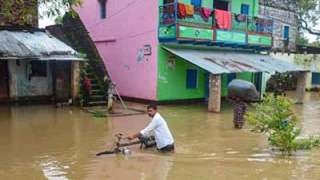MEDIA
Opinion: Rising menace of floods
www.telanganatoday.com | August 13, 2021
Recent floods have adversely affected many States. The three-fold rise in rainfall across India, caused devastating floods, especially in Maharashtra. In May, severe cyclonic storm Tauktae affected Maharashtra, and now the State is dealing with twin disasters, ie, floods and the Covid pandemic.
According to the Humanitarian Aid International (HAI) report, 209 people died due to floods and landslides, and 4,34,185 people were evacuated to safer places in eight districts in Maharashtra. In addition, damage to private and public properties stood at over Rs 4,000 crore, and 3,38,000 hectares of crop area have been damaged in the western Maharashtra and Konkan regions. Floods also adversely impacted infrastructure, including roads and bridges, electricity infrastructure and drinking water supply. The Government of India declared a financial aid of Rs 700 crore for Maharashtra.
Recurring Problem
Urgent flood control and mitigation are essential for minimising the impact of floods. According to the Central Water Commission Report, Maharashtra has lost around Rs 852 crore due to floods between 1953 and 2017. Of this, the damage to public infrastructure stood at Rs 331 crore, followed by crop damage at Rs 305 crore and houses at Rs 305 crore. During this period, 4,746 people were killed, 15 million population were affected, 2.25 million hectare crop areas devastated and 1.26 million houses were damaged. In addition, every year, on average, the loss to Maharashtra due to floods is around Rs 15 crore, and the State sees 88 deaths while crop loss is at Rs 5.74 crore.
For other States, damage reported stood at around Rs 742 crore and 64 deaths in 2021, according to the Emergency Events Database (EM-DAT). This year, India experienced two severe cyclones, Tauktae and Yaas, that killed 199 people, affected 37 million and caused a financial loss of Rs 32,000 crore. (see infographics)
Frequent flooding not only adversely affects the economy but also increases the financial pressure of governance. A 2021 working paper from IRMA (Parida et al) confirms that India lost around 0.46% of GDP annually due to floods. The government spends around 0.23% of GSDP annually on relief distribution, evacuation and rehabilitation activities. Based on the frequency of floods, India is one of the most flood-affected nations globally after China.
India’s geoclimatic conditions have caused higher flood fatalities and damage. Other factors such as irregular rainfall, higher urbanisation, complex population density, deforestation, illegal constructions, environmental degradation and inadequate drainage facilities have also contributed to increasing flood damage. Flood is the costliest disaster that accounts for 68% of the total disaster damage and is the second most lethal disaster after earthquakes.
Female Fatality
Moreover, female flood fatality is higher than males (World Development, 2021. Joyita Roy Chowdhury, Parida and Agarwal Goel). Socially constructed responsibilities and cultural beliefs restrict the participation of women in social, political, and economic decision-making, and women remain unaware of flood warnings and mitigation measures. Restricted mobility of women to non-agricultural sectors also increases their vulnerability to flood fatalities.
Floods in India pose a serious threat to the economy and the livelihood of poor rural households. Frequent floods increase poverty, rural inequality and food shortage due to crop damage and income loss for rural households. To avoid the impact of flooding, the Central and State governments have devised long-term flood management policies. A paper published in ‘Nature 2021’ (Roy Chowdhury, Parida and Sahoo) suggests that the construction of river embankments and improved river connectivity help in minimising the impact of natural disasters. Additionally, improved flood warning and flood forecasting and construction of a multipurpose shelter in low-lying areas may help mitigate flood fatalities.
Long-Term Measures
Rapid urbanisation, inadequate drainage facilities and illegal constructions create urban flooding. The National Flood Commission recommendations have failed to achieve much success in mitigating floods and the data shows that flood damage and fatalities have increased. To minimise the flood impact, we suggest that both State and Central government devise long-term flood mitigation measures and invest more in building flood-resilient infrastructure.
In addition, they should generate ex-ante flood mitigation measures such as improving flood warning and forecasting systems in low lying areas and take up construction of river embankments, expedite interlinking of rivers and increase afforestation measures. These to some extent should minimise the impact and reduce the ex-post expenditure required for activities such as evacuation, relief distributions and rehabilitation. Investment in ex-ante measures would not only mitigate damage but also help in raising the inequality-adjusted human development index (IHDI) that is found to be associated with reducing flood fatalities.
Another major issue is the incorrect measurement of State-wise flood-prone areas. More advanced and scientific methods for measuring State and district-wise flood-prone areas are required. The government should also undertake district-wise Flood Inundation Mapping for categories of districts based on the severity of floods. Creating a massive awareness campaign at the community level for flood preparedness measures is the need of the hour.
The State governments should conduct regular meetings before monsoon to evaluate disaster preparedness. A national disaster database will help policymakers and academics devise long-term flood management policies. To summarise, building climate-resilient infrastructure and better flood mitigations measures should help avoid flood situations in India, save lives and reduce damage.
(Yashobanta Parida is Assistant Professor, Economics, FLAME University, Pune; Prarthna Agarwal Goel is Assistant Professor, Economics, GGS Indraprastha University, New Delhi, and Tapaswini Nayak is Lecturer in Economics at PN College (Autonomous). Odisha, Views are personal)

Damage from Floods (1953 and 2017)
• Total damage (including houses, crops, public utilities) – Rs 3,78,247 crore
• Public utilities (road, canals, electricity, water supply, public buildings) – Rs 2,12,060 crore
• Crops – Rs 1,11,226 crore
• Houses – Rs 53,774 crore
• People killed: 107,535
• Affected – 2,088 million
• Total Damage (average) – around Rs 5,819 crore
Source: Central Water Commission

(Source: https://telanganatoday.com/opinion-rising-menace-of-floods)

